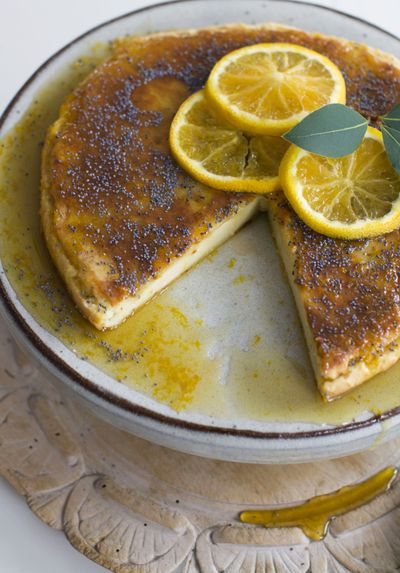Orange cheesecake celebrates another Hanukkah tradition

Everyone knows – or at least every Jew knows – the story of Hanukkah’s origins, the story of how just a tiny amount of oil miraculously burned for eight days. And they know that, in the spirit of that story, Hanukkah is celebrated in part by eating foods fried in oil, such as latkes and doughnuts.
But in much of the world, Hanukkah also is celebrated by eating salty cheeses. And for that, there is another and equally fascinating – though in the U.S. lesser known – story.
The short version goes something like this: Around 2 B.C., a Jewish widow saved her people by ingratiating herself with an enemy general, plying him with salty cakes of cheese, then wine to quench the thirst it brought. When he fell into a drunken stupor, she lopped off his head with his own sword.
When this story became associated with Hanukkah is unclear. Jewish cookbook author Joan Nathan says Hanukkah most likely was originally celebrated around the winter solstice and that the role of oil was related to the light it helped create during this darkest time of year.
Olive oil became an important part of this “festival of lights” and the foods eaten during the celebration were a nod to this, as was the story of the miraculous and essential oil. Latkes, or pancakes fried in oil, were initially made of eggs and flour or sometimes cheese, and this could be when the story of the salty cheese cakes took off.
Jews in Southern Europe gravitated toward the Hanukkah dairy tradition and often prepared a variation of savillum, a traditional Roman cheesecake made with ricotta, eggs, flour and honey.
The potato latke came later, says Nathan, when locals adapted the fried pancake tradition to a crop they had on hand in great abundance.
Dennis Wasko, a kosher chef from Chicago, grew up with the oil tradition of Hanukkah but in recent years has added dairy to his family’s tradition. He likes to make a Sephardic-style cheese fritter called bunuelos de queso, which are made with eggs, flour and a salty dry cheese such as Greek mizithra, ricotta salata or even farmer’s cheese.
The mixture is formed into little balls or pancakes, then fried in oil (tying in the other popular Hanukkah tradition) and served drizzled with honey.
Wasko says that he has even commemorated the story of the widow and the general more literally by serving a dish of salty cheese along with some wine to quench the thirst it inevitably creates. Of course, he leaves the beheadings out of the celebration.
Roman Cheesecake with Orange-Scented Honey
6 fresh bay leaves
2 large eggs, beaten
1 teaspoon vanilla extract
Grated zest of 2 oranges, divided
1 1/2 cups whole milk ricotta cheese
1/2 cup all-purpose flour
1/3 cup honey (orange blossom if possible)
1 tablespoon poppy seeds
Heat the oven to 375 degrees. Line a baking sheet with parchment paper. Arrange the bay leaves in the center of the parchment in an 8-inch circular pattern.
In a medium bowl, beat together the eggs, vanilla and half of the orange zest. Beat in the ricotta, then the flour. The mixture should form a thick batter. Scoop the batter onto the arranged bay leaves on the prepared baking sheet. Use a silicone spatula or the back of a spoon to spread the batter into an 8-inch circle over the bay leaves.
Bake for 20 to 25 minutes, or until golden and puffy.
Meanwhile, in a small saucepan over medium-low heat, combine the honey and remaining orange zest. Heat for several minutes until thin and warmed.
When the cake is done baking, use a wooden skewer to poke holes in the top of the cheesecake. Drizzle a third of the warmed honey over the cake, letting it soak into the surface. Place a serving plate over the cake, then overturn so that the cake is on the plate. Use the skewer to poke holes in the surface again, then drizzle the rest of the honey over the cake.
Let the cheesecake rest for at least 30 minutes to allow the honey to soak in. Sprinkle with poppy seeds, then cut into 6 wedges and serve warm or at room temperature.
Yield: 6 servings
Approximate nutrition per serving: 240 calories, 10 grams fat (6 grams saturated, 38 percent total fat calories), 11 grams protein, 27 grams carbohydrate, 90 milligrams cholesterol, 1 gram dietary fiber, 75 milligrams sodium, 16 grams sugar, 75 milligrams sodium.